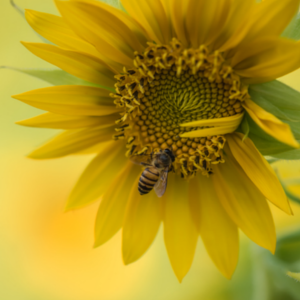
Many people believe they are allergic to bee stings because of the reaction they experience. It’s however perfectly normal to experience pain, swelling, redness and even itching. Even if the sting site is red, swollen, itchy and painful the next day, it doesn’t mean you’re allergic to bee stings.
Bee-sting allergies
A bee sting contains venom made up of peptides and enzymes that cause your body to release histamine. The histamine causes blood vessels to dilate, allowing immune cells to reach the sting site and help heal your body.
When you have a bee-sting allergy, however, your body releases too much histamine. This causes extreme dilation of the blood vessels, which means they can no longer regulate blood pressure. Your blood pressure drops and cells stop receiving oxygen – with the result that you go into anaphylactic shock and struggle to breathe. This can happen quickly and must be treated as a medical emergency.
When this happens, epinephrine is administered, which helps constrict your blood vessels. Your blood pressure returns to normal and oxygen begins to circulate around your body once again.
Read: Beware of bee stings
How should I remove the sting?
Do you still believe that you should scrape a sting out rather than pull it out? A study published in the August 1996 Lancet dispels the myth that pulling a sting out will release more of the venom.
Researchers at the University of California, Riverside, and Pennsylvania State University tested the theory by measuring the size of the wheals left by a bee sting. The stings were left in for 0.5 seconds, 1, 2, 4, or 8 seconds and then scraped out using a credit card, and then again, using the same intervals, the stings were pulled out. And here’s the kicker – there was no difference in wheal size! The only factor that changed the size of the wheal was how long the stings were left in.
Read: Cheap generic alternative to EpiPen on market
Why does a bee sting hurt?
Usually the first sign that you’ve been stung by a bee is pain. This is your body reacting to the venom. There are three toxic effects:
1. Neurotoxic: paralysis of the local nervous system
2. Haemorrhagic: increased permeability of the blood capillaries
3. Haemolytic: destruction of red blood cells
Read: Take the itch out of insect bites and stings
Avoid getting stung
Take these precautions to avoid getting stung this summer:
• If you’re drinking cooldrinks outside, use a cup so you can see if a bee flies in. Always inspect cans and straws before using them.
• Avoid walking around barefoot outside in case you step on a bee – even better, wear close-toed shoes.
• Brightly coloured clothing with floral prints can attract bees. Don’t wear loose clothing – the bees can find themselves trapped between the fabric and your skin.
• Avoid using fragrances, hair spray, scented soaps, lotions and oils.
• Always have beehives and wasp nests removed by professionals.
Read more:
SEE: Where are some of the most common allergens in SA?
Sources:
Bee SpotterDr Greene
How Stuff Works
Poison.org
Mayo Clinic




 Publications
Publications
 Partners
Partners











